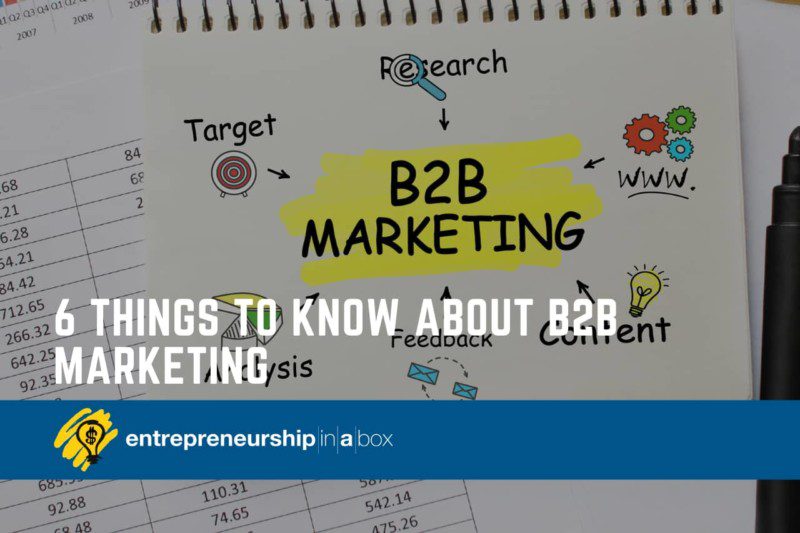Over the past 20 years or so, B2B marketing has become its own discipline. Business-to-business marketing requires a different approach from what you use for consumers or end users.
Essentially, B2B marketing is one of two major marketing categories, with the other being B2C, or business-to-consumer.
You can define B2B marketing as the promotion of services and products to other businesses, usually at large volumes and with long sales cycles. B2B marketing also includes multiple decision-makers, and there’s more complexity that you’re dealing with compared to B2C.
The business definition of B2B marketing can simply be the process of marketing products or services to other businesses that they’re going to use as part of the production, general business operations, or reselling to their customers.
With B2B marketing, you’re letting other companies know you exist and you have a product or service available that can potentially benefit them. You can use B2B marketing to raise brand awareness, and you’re also working with the ultimate goal of converting businesses into long-term customers.
The following are some of the important things to know about B2B marketing.
1. B2B vs. B2C
The two goals of these types of marketing are pretty much the same, but it’s the approach where things diverge quite a bit.
With business-to-consumer marketing, you’re promoting products or services to individuals for their personal use or enjoyment. There are a lot of examples of B2C marketing we come across in our daily lives.
While B2C products and services are for individuals who will be using them personally, B2B products and services are for use by different types of businesses and often have a high price tag. The B2C selling cycle can be much faster, while you can expect it’s going to be long with B2B. When a business makes a purchase, they’re typically making a commitment to doing so. For example, maybe they’re committing in the form of a contract.
There are a lot of factors that go into a B2B purchase, often because there are multiple people who are decision-makers in this scenario. B2C purchases can be more emotionally driven, and they may be more of an impulse buy, whereas this isn’t likely to happen in a B2B situation.
2. Who’s Using B2B Marketing?
Software companies are a great example of a B2B organization. Software is what helps businesses operate efficiently and provide an excellent customer experience.
Other examples include marketing, office supply companies, and accounting.
3. Marketing Channels
A B2B channel is a route you’re taking to connect with possible customers. The channel will determine your messaging in a lot of ways.
You can break down your channels into two categories—offline and online.
Online marketing channels include your website, social media, digital advertising, and email marketing. Offline B2B marketing channels, which aren’t very relied on in B2C marketing, can include tradeshows and industry events, public relations, direct mail, and print ads.
4. The Process
The buyer’s journey is whatever process your potential buyers will go through before they decide to buy from you. The journey is based on three main touchpoints, which are awareness, consideration, and decision.
During the awareness stage, your buyer realizes there’s a problem, and they start to look for solutions. As far as your marketing, and especially your digital marketing, you want to use intent data. You can then put yourself directly in front of prospects who are ready to buy and need a solution you have available.
The consideration stage is when a B2B buyer is putting their research together and working on finding the best solution to solve their problem.
The decision stage is when a buyer makes a purchasing decision.
In B2B marketing, you might also see the retention stage. This is because, again, B2B companies have to build their relationships with current buyers as well as try to get new ones.
5. The Challenges
There are unique challenges in B2B marketing, and understanding what you’re up against will help you build out the most effective strategies.
Challenges that come with B2B marketing include:
- There’s a lot of competition. The modern sales environment is filled with noise, and as a marketer, you have to think about how you’re going to cut through it and get the attention of your targeted audience. The value that you’re bringing to the situation is ultimately your most important tool to deal with this challenge. Create high-quality content and a personalized prospect experience to highlight your value.
- It can be tough to get high-quality data, and that can lead to B2B marketers focusing on the wrong targets. If you can start with an ideal customer profile, this is a good jumping-off point to understand more about who you’re targeting and how you should speak to them.
- The buying cycles, as has been mentioned, are long with B2B sales. The sales cycle is longer largely because there are more decision-makers that are involved, so there can be months spent in one stage of the funnel. To move prospects through and shorten the cycle, you have to nurture them with a personalized experience. You also want to make sure that you’re targeting the right person. Sales cycles can be longer than they need to be if you initially target the wrong person or your sales team does.
- There may be a misalignment between sales and marketing. Marketing might not be getting the needed qualified leads, and the sales team may not follow up on leads. There’s a general disconnect that’s hampering business growth. Your sales and marketing teams need a direct line of communication with one another.
6. Best Practices
For B2B marketing, start by identifying your targeted buyers and doing the research to create personas. You want to make sure that you have an omnichannel presence so that you can reach prospects no matter where they’re doing research.
You also have to qualify leads and then create routes for nurturing and educating them. Educational content is a huge part of B2B marketing. Finally, make sure you’re always measuring results, so you can see your ROI and where you may need to shift your strategy.





